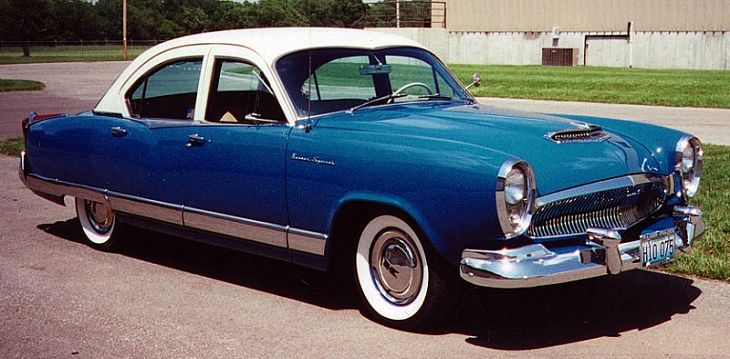Description
The Kaiser Special was the foundation of the Kaiser-Frazer lineup and one of the most representative cars of America’s postwar motoring revival. Introduced in 1947 and produced in various forms into the early 1950s, the Special embodied Henry J. Kaiser’s vision of a modern, affordable, and well-engineered automobile for a nation eager to move beyond wartime austerity. It was designed to appeal to the average American family—spacious, comfortable, and attractively styled, yet economical to buy and operate.
When Kaiser-Frazer began producing cars in 1946 for the 1947 model year, it was one of the few entirely new names to appear in the U.S. automotive industry after World War II. Where most established manufacturers simply reworked prewar designs, Kaiser introduced a car that was fresh, modern, and forward-looking. The Special was the entry-level model, sitting below the more luxurious Custom and DeLuxe trims, but it shared the same progressive styling and mechanical design that made the Kaiser lineup stand out.
Under the hood, the Kaiser Special was powered by the Continental Red Seal inline-six engine—a 226 cubic inch (3.7-litre) flathead unit producing around 100 horsepower in early versions. Known for its smoothness and durability, this six-cylinder engine provided dependable performance for everyday driving. It was mated to a three-speed manual transmission, with optional overdrive available for more relaxed highway cruising and improved fuel efficiency. The combination gave the Special a quiet, easygoing nature that suited its role as a family sedan.
Mechanically, the Special was built on a solid foundation. Its 123.5-inch wheelbase provided generous interior space, while independent front suspension with coil springs—advanced for its time—delivered a comfortable and stable ride. The rear used semi-elliptic leaf springs for strength and simplicity, and hydraulic drum brakes on all four wheels ensured reliable stopping power. Though not fast, the Kaiser Special was smooth and predictable on the road, with light steering and excellent straight-line stability.
The styling of the Kaiser Special was one of its greatest strengths. Designed under the guidance of Howard “Dutch” Darrin, the car’s body was sleek and modern, emphasizing smooth, flowing lines and integrated fenders rather than the bulky, separate shapes that had characterized prewar designs. The front featured a wide horizontal grille with fine chrome detailing, while the sides were clean and uncluttered, accentuating the car’s length and low stance. The proportions were well balanced, giving the Special a confident, dignified appearance that stood out among its more conservative rivals.
Inside, the Special offered a simple but comfortable cabin that reflected Kaiser’s attention to practicality and good taste. The interior materials were durable rather than opulent—broadcloth upholstery, painted metal trim, and rubber or carpeted flooring—but the layout was ergonomic and well thought out. The dashboard was symmetrical and functional, with large, clearly marked gauges and easy-to-reach controls. Visibility was excellent thanks to the car’s wide glass area and thin pillars, and the spacious seating arrangement provided ample room for five or six passengers.
As an entry-level model, the Kaiser Special was aimed at value-conscious buyers, but it was far from basic. Standard equipment included dual sun visors, armrests, and a heater, while options such as a push-button radio, clock, and whitewall tires allowed owners to personalize their cars. The quality of construction and attention to fit and finish were impressive for a small manufacturer, reinforcing the impression that even the most affordable Kaiser was built to a high standard.
Driving the Special revealed a car that prioritized comfort and refinement over performance. The Continental six was quiet and flexible, delivering its torque smoothly at low speeds. The suspension absorbed rough roads with composure, and the car tracked straight and true at highway speeds. It was a steady, reliable companion for daily driving or long-distance touring, perfectly suited to the growing network of American highways in the late 1940s.
In 1949, the Special received a mild redesign that modernized its appearance. The grille was widened and simplified, the rear fenders were more integrated, and the roofline was slightly lower. The result was a sleeker, more contemporary look that kept the model competitive in a rapidly evolving market. The following year saw minor refinements to interior materials and trim, but the overall formula remained the same—an honest, well-built car designed for ordinary Americans.
The Kaiser Special played a crucial role in establishing the brand’s reputation. It was priced competitively against Chevrolet, Ford, and Plymouth, but offered more interior space and a more modern design. In its best years, it helped push Kaiser-Frazer into the ranks of America’s top five automakers—a remarkable achievement for a company founded only a few years earlier.
Today, the Kaiser Special is remembered as one of the most significant cars produced by an independent American automaker in the postwar period. It reflects the optimism and creativity that defined the era, when innovation was driven not just by scale, but by vision. Collectors appreciate the Special for its clean lines, roomy interior, and historical importance as the car that helped launch Kaiser-Frazer’s automotive venture.
The Special was never meant to be extravagant; instead, it embodied practicality and progress. It showed that a family sedan could be stylish, comfortable, and forward-looking without being expensive. In its design, engineering, and spirit, the Kaiser Special stood as a car for a new generation of Americans—modern, confident, and eager to move ahead.
